YAMAHA VX-C 2021 Bruksanvisningar (in Swedish)
Manufacturer: YAMAHA, Model Year: 2021, Model line: VX-C, Model: YAMAHA VX-C 2021Pages: 214, PDF Size: 4.23 MB
Page 21 of 214
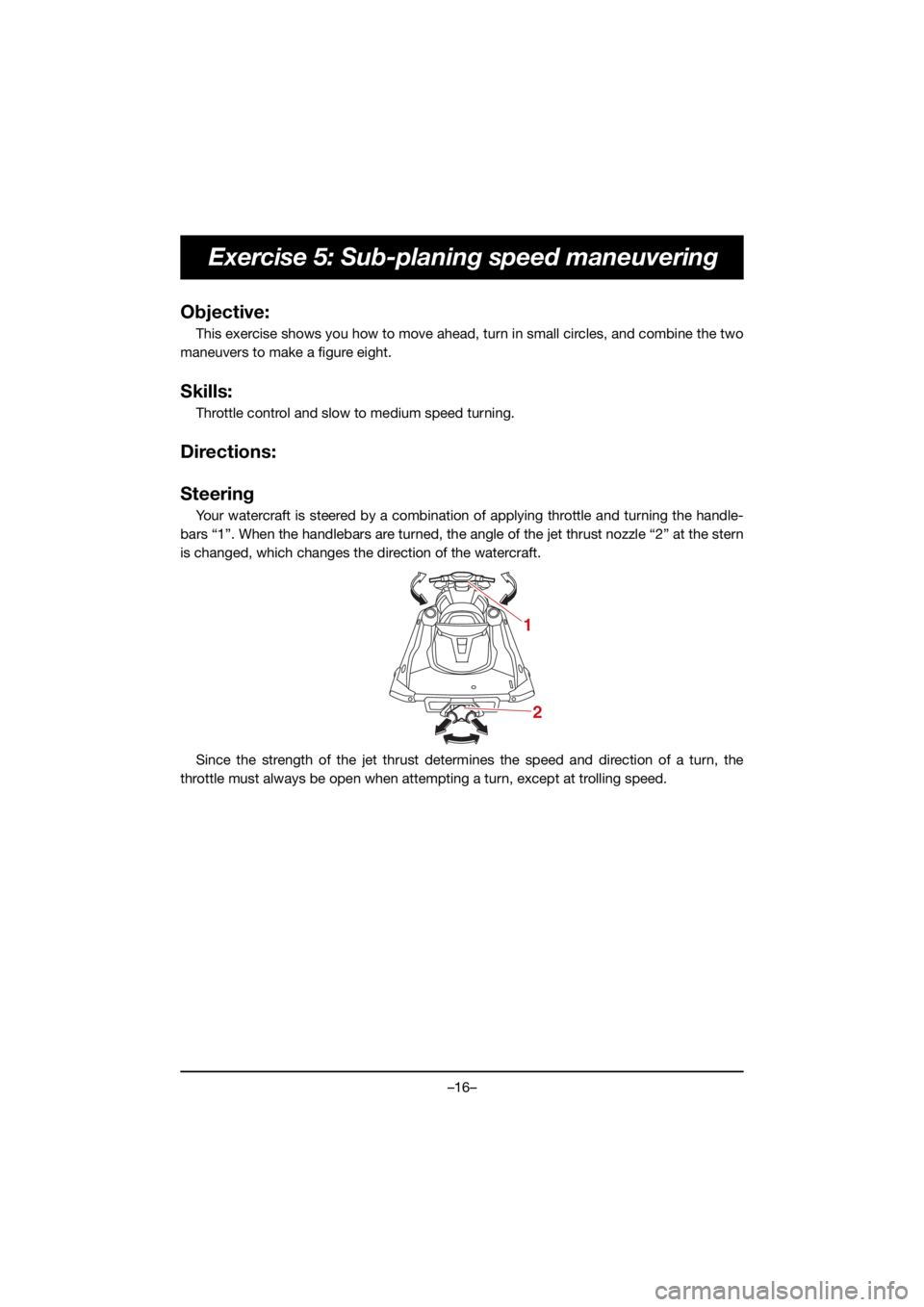
–16–
Exercise 5: Sub-planing speed maneuvering
Objective:
This exercise shows you how to move ahead, turn in small circles, and combine the two
maneuvers to make a figure eight.
Skills:
Throttle control and slow to medium speed turning.
Directions:
Steering
Your watercraft is steered by a combination of applying throttle and turning the handle-
bars “1”. When the handlebars are turned, the angle of the jet thrust nozzle “2” at the stern
is changed, which changes the direction of the watercraft.
Since the strength of the jet thrust determines the speed and direction of a turn, the
throttle must always be open when attempting a turn, except at trolling speed.
1
2
F4N-70-forPrint.book Page 16 Tuesday, October 6, 2020 9:08 AM
Page 22 of 214
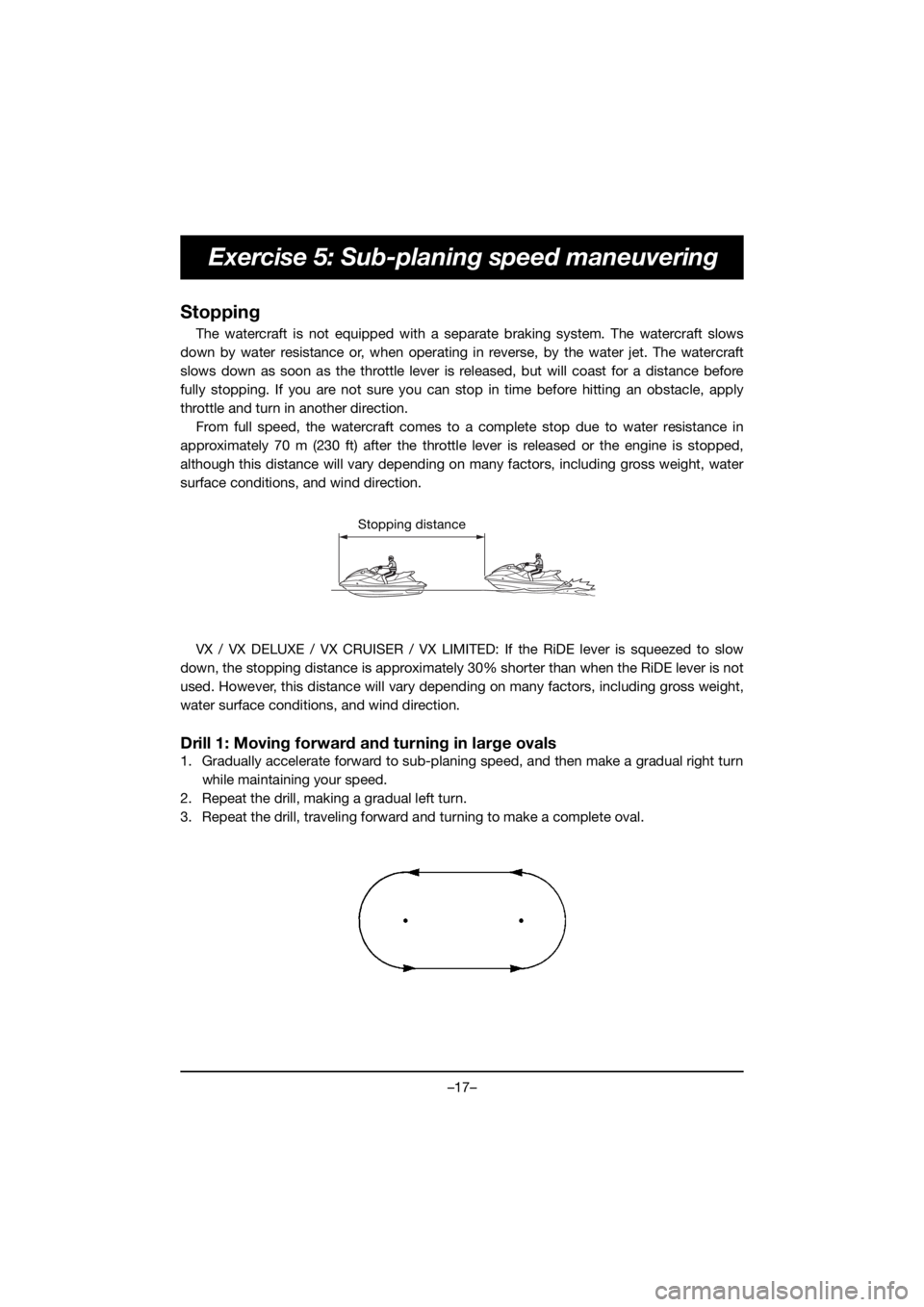
–17–
Exercise 5: Sub-planing speed maneuvering
Stopping
The watercraft is not equipped with a separate braking system. The watercraft slows
down by water resistance or, when operating in reverse, by the water jet. The watercraft
slows down as soon as the throttle lever is released, but will coast for a distance before
fully stopping. If you are not sure you can stop in time before hitting an obstacle, apply
throttle and turn in another direction. From full speed, the watercraft comes to a complete stop due to water resistance in
approximately 70 m (230 ft) after the throttle lever is released or the engine is stopped,
although this distance will vary depending on many factors, including gross weight, water
surface conditions, and wind direction.
VX / VX DELUXE / VX CRUISER / VX LIMITED: If the RiDE lever is squeezed to slow
down, the stopping distance is approximately 30% shorter than when the RiDE lever is not
used. However, this distance will vary depending on many factors, including gross weight,
water surface conditions, and wind direction.
Drill 1: Moving forward and turning in large ovals
1. Gradually accelerate forward to sub-planing speed, and then make a gradual right turn while maintaining your speed.
2. Repeat the drill, making a gradual left turn.
3. Repeat the drill, traveling forward and turning to make a complete oval.
Stopping distance
F4N-70-forPrint.book Page 17 Tuesday, October 6, 2020 9:08 AM
Page 23 of 214
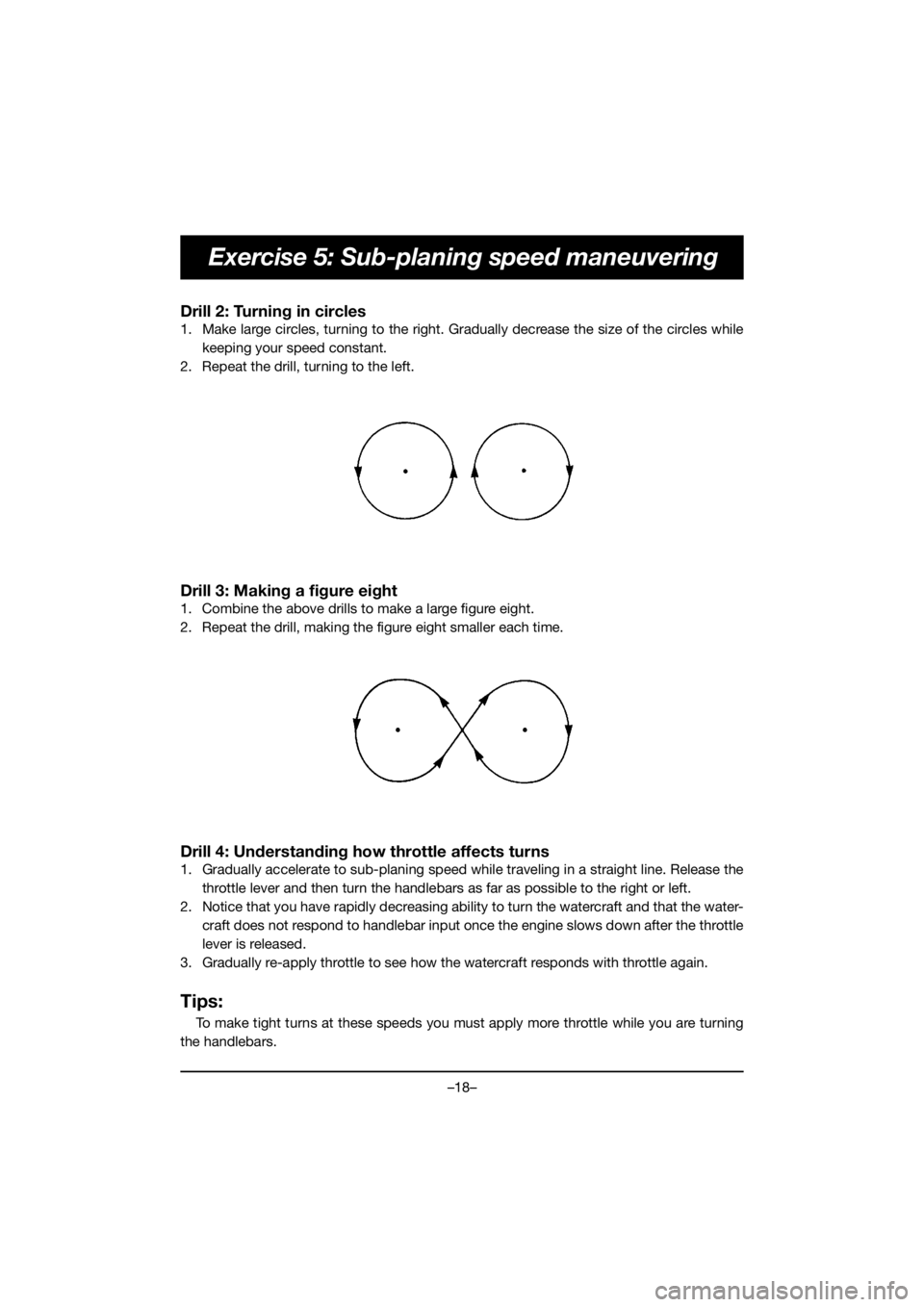
–18–
Exercise 5: Sub-planing speed maneuvering
Drill 2: Turning in circles
1. Make large circles, turning to the right. Gradually decrease the size of the circles whilekeeping your speed constant.
2. Repeat the drill, turning to the left.
Drill 3: Making a figure eight
1. Combine the above drills to make a large figure eight.
2. Repeat the drill, making the figure eight smaller each time.
Drill 4: Understanding how throttle affects turns
1. Gradually accelerate to sub-planing speed while traveling in a straight line. Release the throttle lever and then turn the handlebars as far as possible to the right or left.
2. Notice that you have rapidly decreasing ability to turn the watercraft and that the water- craft does not respond to handlebar input once the engine slows down after the throttle
lever is released.
3. Gradually re-apply throttle to see how the watercraft responds with throttle again.
Tips:
To make tight turns at these speeds you must apply more throttle while you are turning
the handlebars.
F4N-70-forPrint.book Page 18 Tuesday, October 6, 2020 9:08 AM
Page 24 of 214
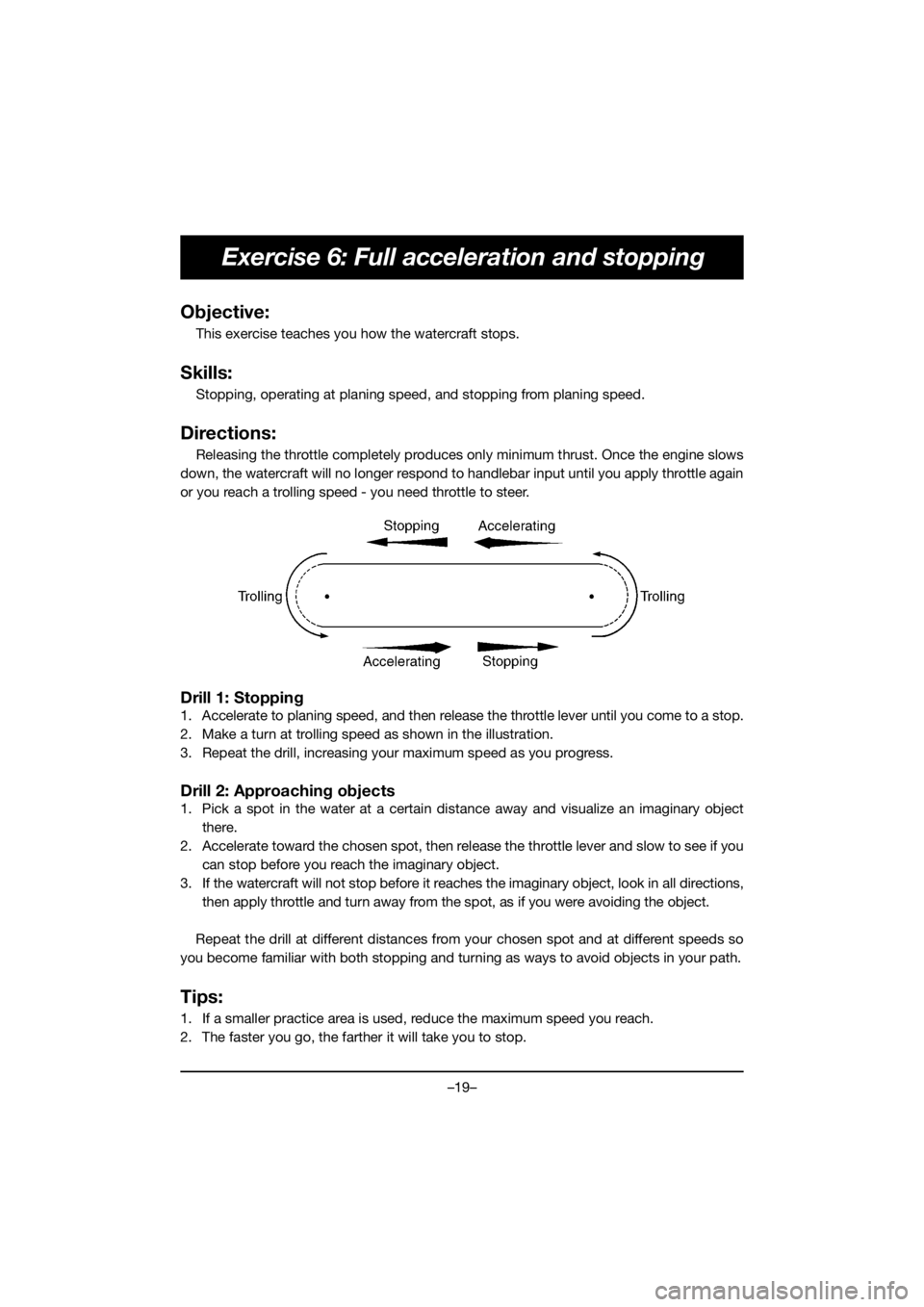
–19–
Exercise 6: Full acceleration and stopping
Objective:
This exercise teaches you how the watercraft stops.
Skills:
Stopping, operating at planing speed, and stopping from planing speed.
Directions:
Releasing the throttle completely produces only minimum thrust. Once the engine slows
down, the watercraft will no longer respond to handlebar input until you apply throttle again
or you reach a trolling speed - you need throttle to steer.
Drill 1: Stopping
1. Accelerate to planing speed, and then release the throttle lever until you come to a stop.
2. Make a turn at trolling speed as shown in the illustration.
3. Repeat the drill, increasing your maximum speed as you progress.
Drill 2: Approaching objects
1. Pick a spot in the water at a certain di stance away and visualize an imaginary object
there.
2. Accelerate toward the chosen spot, then release the throttle lever and slow to see if you can stop before you reach the imaginary object.
3. If the watercraft will not stop before it reach es the imaginary object, look in all directions,
then apply throttle and turn away from the spot, as if you were avoiding the object.
Repeat the drill at different distances from your chosen spot and at different speeds so
you become familiar with both stopping and turning as ways to avoid objects in your path.
Tips:
1. If a smaller practice area is used, reduce the maximum speed you reach.
2. The faster you go, the farther it will take you to stop.
F4N-70-forPrint.book Page 19 Tuesday, October 6, 2020 9:08 AM
Page 25 of 214
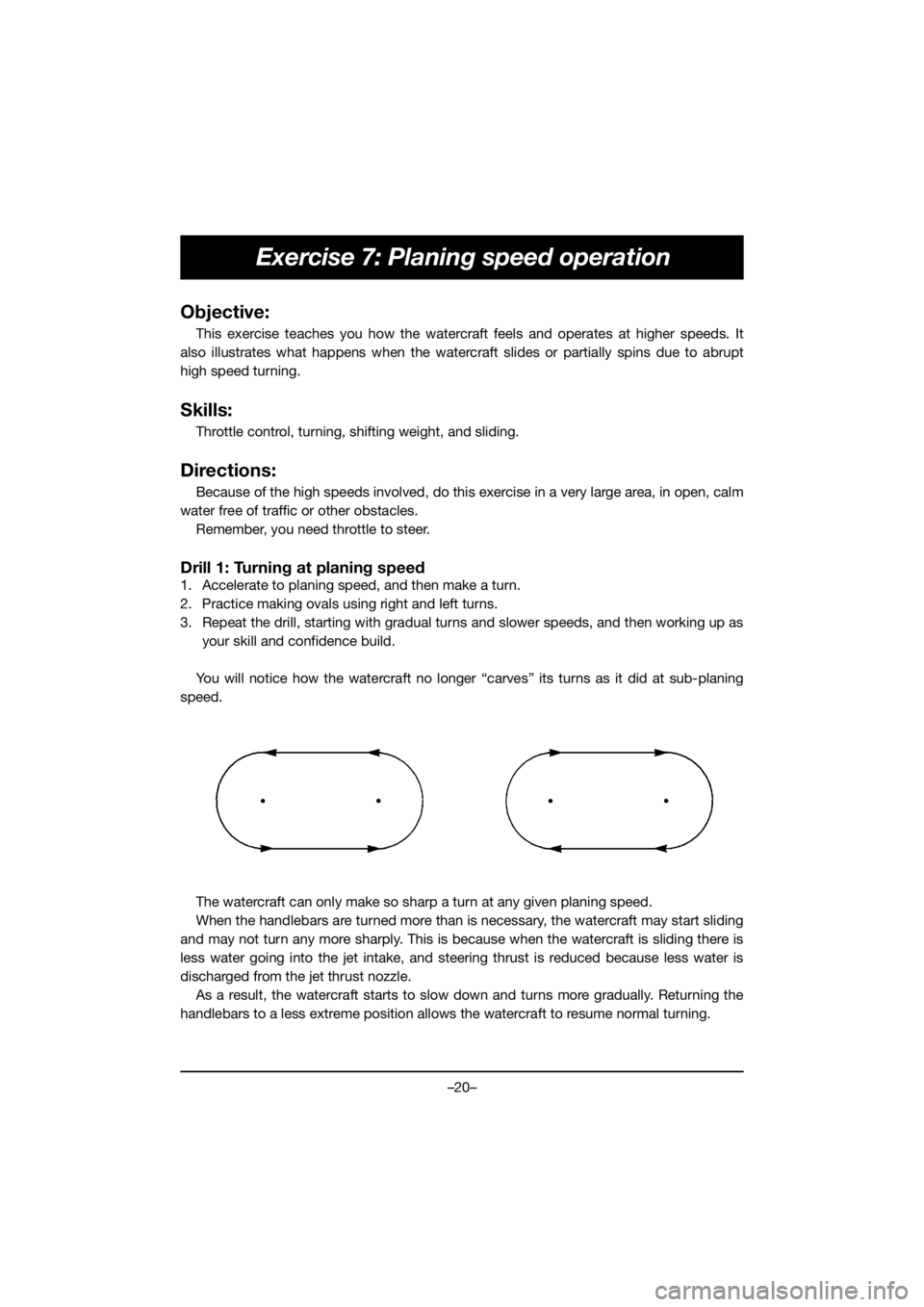
–20–
Exercise 7: Planing speed operation
Objective:
This exercise teaches you how the watercraft feels and operates at higher speeds. It
also illustrates what happens when the watercraft slides or partially spins due to abrupt
high speed turning.
Skills:
Throttle control, turning, shifting weight, and sliding.
Directions:
Because of the high speeds involved, do this exercise in a very large area, in open, calm
water free of traffic or other obstacles. Remember, you need throttle to steer.
Drill 1: Turning at planing speed
1. Accelerate to planing speed, and then make a turn.
2. Practice making ovals using right and left turns.
3. Repeat the drill, starting with gradual turns and slower speeds, and then working up as your skill and confidence build.
You will notice how the watercraft no longer “carves” its turns as it did at sub-planing
speed.
The watercraft can only make so sharp a turn at any given planing speed.
When the handlebars are turned more than is necessary, the watercraft may start sliding
and may not turn any more sharply. This is because when the watercraft is sliding there is
less water going into the jet intake, and steering thrust is reduced because less water is
discharged from the jet thrust nozzle. As a result, the watercraft starts to slow down and turns more gradually. Returning the
handlebars to a less extreme position allows the watercraft to resume normal turning.
F4N-70-forPrint.book Page 20 Tuesday, October 6, 2020 9:08 AM
Page 26 of 214
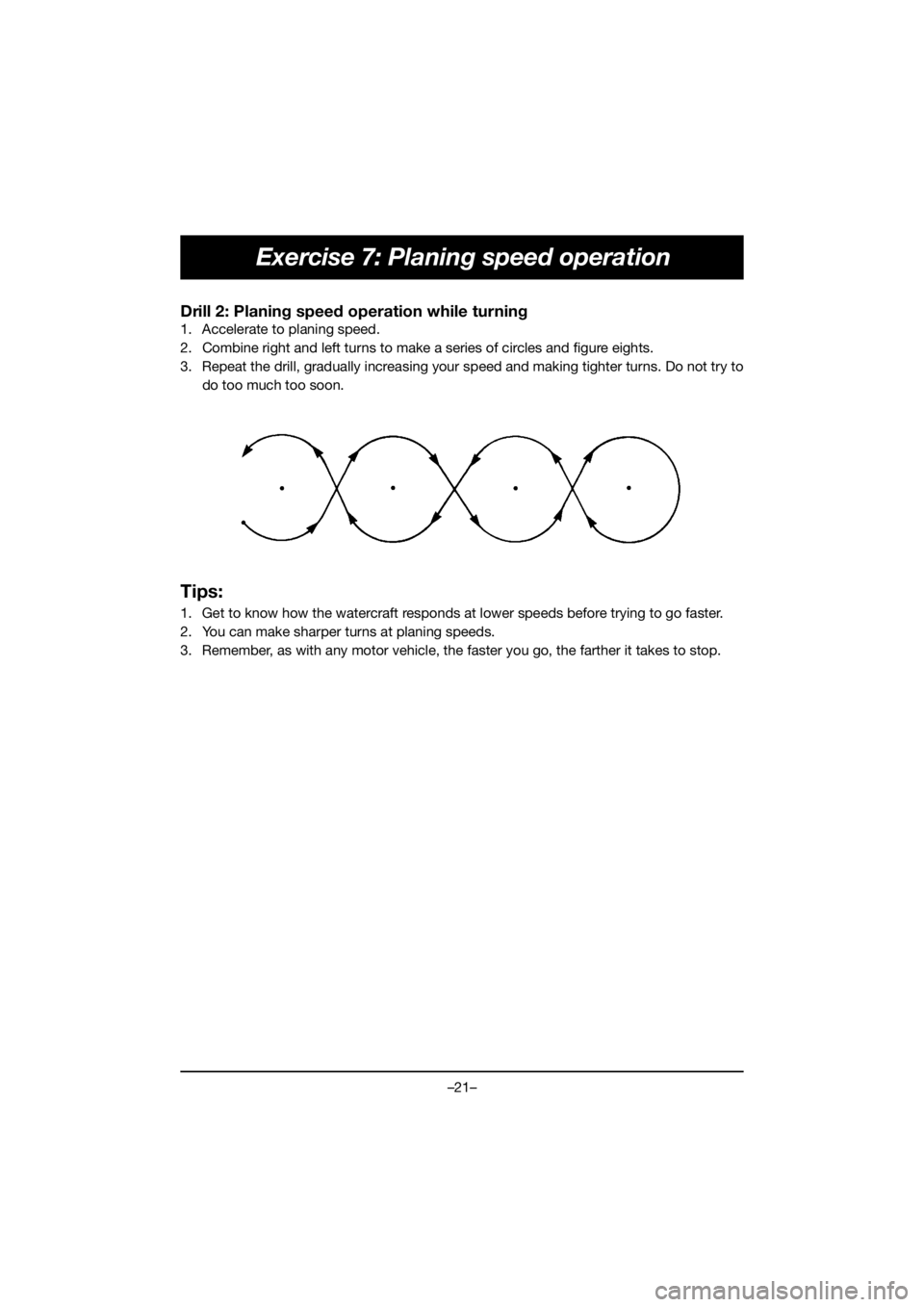
–21–
Exercise 7: Planing speed operation
Drill 2: Planing speed operation while turning
1. Accelerate to planing speed.
2. Combine right and left turns to make a series of circles and figure eights.
3. Repeat the drill, gradually increasing your speed and making tighter turns. Do not try todo too much too soon.
Tips:
1. Get to know how the watercraft responds at lower speeds before trying to go faster.
2. You can make sharper turns at planing speeds.
3. Remember, as with any motor vehicle, the faster you go, the farther it takes to stop.
F4N-70-forPrint.book Page 21 Tuesday, October 6, 2020 9:08 AM
Page 27 of 214
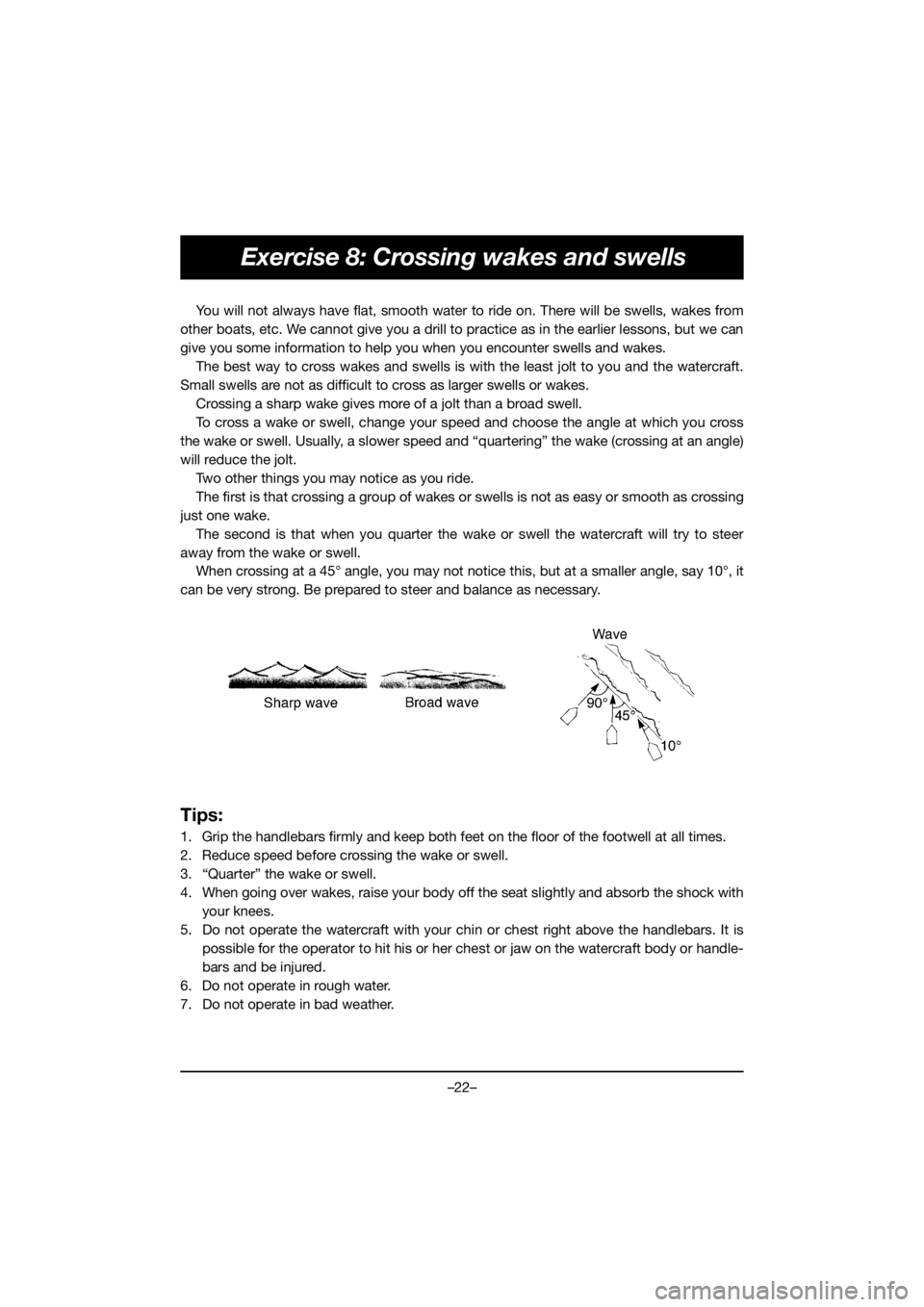
–22–
Exercise 8: Crossing wakes and swells
You will not always have flat, smooth water to ride on. There will be swells, wakes from
other boats, etc. We cannot give you a drill to practice as in the earlier lessons, but we can
give you some information to help you when you encounter swells and wakes. The best way to cross wakes and swells is with the least jolt to you and the watercraft.
Small swells are not as difficult to cross as larger swells or wakes. Crossing a sharp wake gives more of a jolt than a broad swell.
To cross a wake or swell, change your speed and choose the angle at which you cross
the wake or swell. Usually, a slower speed and “quartering” the wake (crossing at an angle)
will reduce the jolt. Two other things you may notice as you ride.
The first is that crossing a group of wakes or swells is not as easy or smooth as crossing
just one wake. The second is that when you quarter the wake or swell the watercraft will try to steer
away from the wake or swell. When crossing at a 45° angle, you may not notice this, but at a smaller angle, say 10°, it
can be very strong. Be prepared to steer and balance as necessary.
Tips:
1. Grip the handlebars firmly and keep both feet on the floor of the footwell at all times.
2. Reduce speed before crossing the wake or swell.
3. “Quarter” the wake or swell.
4. When going over wakes, raise your body off the seat slightly and absorb the shock with your knees.
5. Do not operate the watercraft with your chin or chest right above the handlebars. It is possible for the operator to hit his or her ch est or jaw on the watercraft body or handle-
bars and be injured.
6. Do not operate in rough water.
7. Do not operate in bad weather.
F4N-70-forPrint.book Page 22 Tuesday, October 6, 2020 9:08 AM
Page 28 of 214
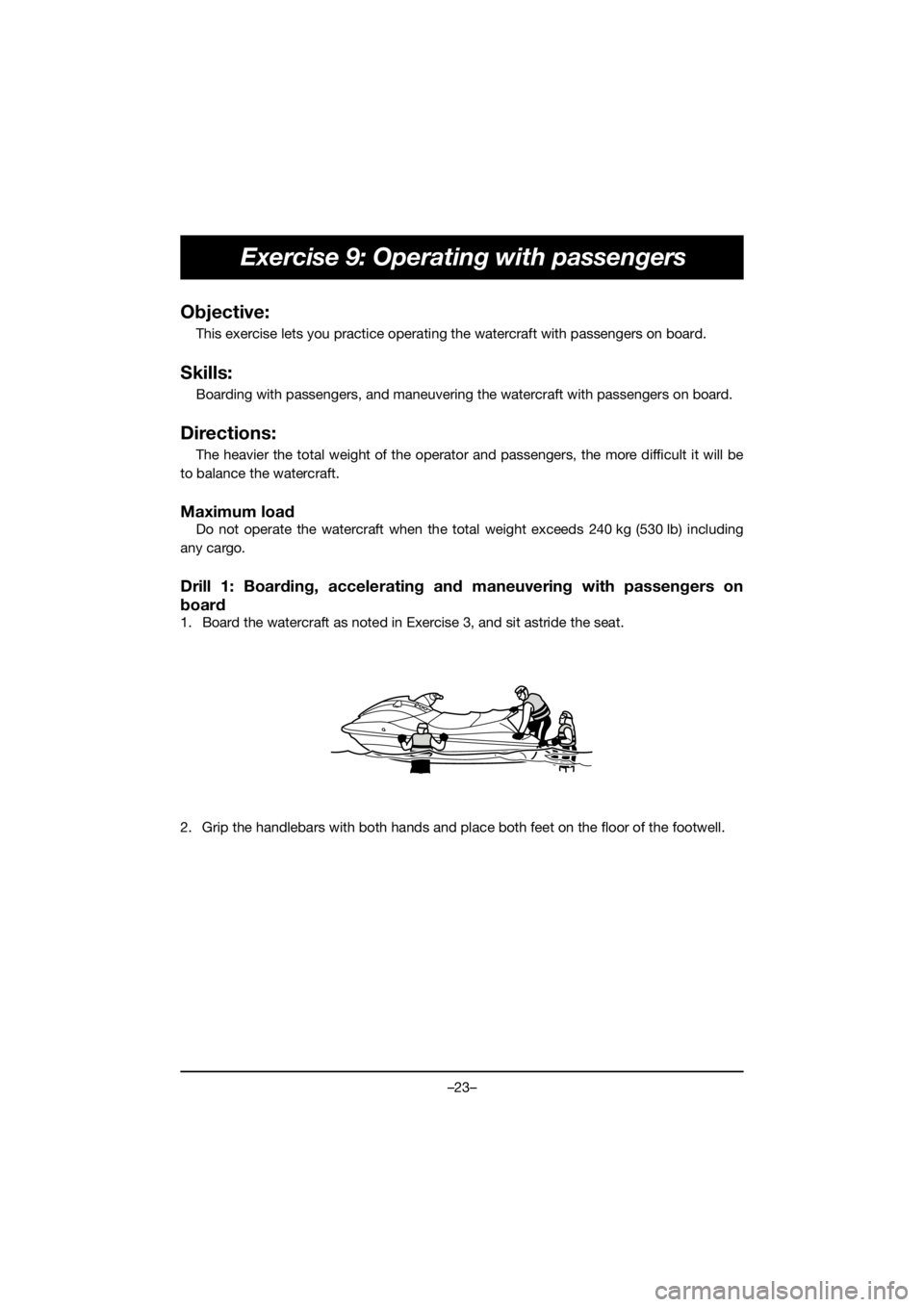
–23–
Exercise 9: Operating with passengers
Objective:
This exercise lets you practice operating the watercraft with passengers on board.
Skills:
Boarding with passengers, and maneuvering the watercraft with passengers on board.
Directions:
The heavier the total weight of the operator and passengers, the more difficult it will be
to balance the watercraft.
Maximum load
Do not operate the watercraft when the total weight exceeds 240 kg (530 lb) including
any cargo.
Drill 1: Boarding, accelerating and maneuvering with passengers on
board
1. Board the watercraft as noted in Exercise 3, and sit astride the seat.
2. Grip the handlebars with both hands and place both feet on the floor of the footwell.
F4N-70-forPrint.book Page 23 Tuesday, October 6, 2020 9:08 AM
Page 29 of 214
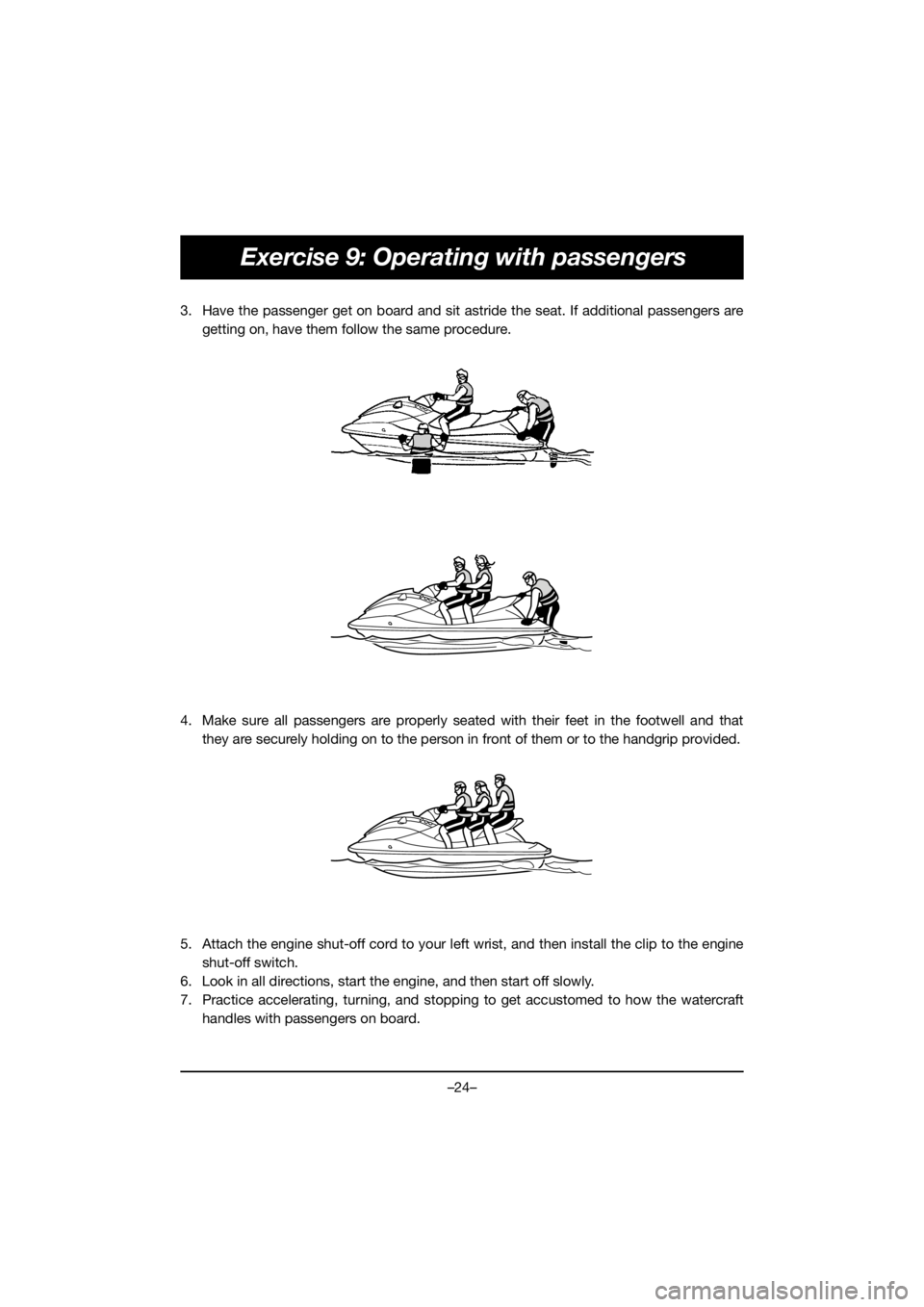
–24–
Exercise 9: Operating with passengers
3. Have the passenger get on board and sit astride the seat. If additional passengers aregetting on, have them follow the same procedure.
4. Make sure all passengers are properly seated with their feet in the footwell and that they are securely holding on to the person in front of them or to the handgrip provided.
5. Attach the engine shut-off cord to your left wrist, and then install the clip to the engine shut-off switch.
6. Look in all directions, start the engine, and then start off slowly.
7. Practice accelerating, turning, and stopping to get accustomed to how the watercraft handles with passengers on board.
F4N-70-forPrint.book Page 24 Tuesday, October 6, 2020 9:08 AM
Page 30 of 214

–25–
Postscript
Watercraft operation requires common sense and good judgment, as well as skills and
knowledge that are learned as riders become familiar with the craft. Although practicing the
exercises contained in this book helps you learn needed skills, you should be aware of your
limits and stay within them as you continue to develop your abilities.
F4N-70-forPrint.book Page 25 Tuesday, October 6, 2020 9:08 AM